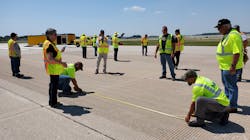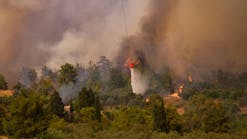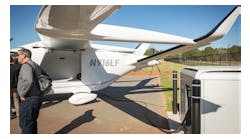Airfield Markings: Sightline Makes a Mark with Training Certification
Airfield markings don’t necessarily get the attention they deserve in today’s high-tech world. Sightline Inc., an education and consulting firm based in Virginia, is on a mission to change that. As the company’s website tagline says, Higher Standards. Sightline doesn’t paint, rather the company works with airports to improve their marking systems.
Company President Donna Speidel has been in the pavement marking business since 1974. She’s been an equipment operator, she’s driven a truck, and it was she who after founding Speidel Construction in 1981, noticed airfield markings lacked the quality and scrutiny of highway markings. In 1998, she started addressing the aviation industry about what could be done.
While strides have been made, Sightline Vice President Mike Speidel (Donna Speidel’s son) said more work needs to be done.
“It’s funny that after all the technological advances, we’re still putting paint and glass on the ground in order to enhance safety,” he said. Pavement markings are basic, but fundamental, not fancy, and they’re not as expensive as some of the other visual aids, but Speidel said that doesn’t mean they are of lesser importance. However, they tend only to get attention when they’re peeling off the pavement or something’s wrong with them.
Sightline looks at markings with a critical eye. As the company philosophy states, “Despite being a relatively small part of airfield operations, markings can make a big difference when applied and maintained properly. Educating the industry to use a proper strategy is the first step to achieving that goal.”
Historically, there’s been a lack of technical training and understanding in this area. In 2008 the Innovative Pavement Research Foundation published the “Airfield Marking Handbook.” Sightline conducted the research for the handbook under a cooperative agreement with the FAA and Donna Speidel was the principal investigator on the project. The handbook includes best practices for specifying construction and maintenance of airfield markings, materials, surface preparation, paint removal, application procedures and inspection.
When asked what could go wrong with pavement markings, Mike Speidel said, “there’s almost always issues.” The origin of an issue could be traced back to design or specification (engineering). On site, generally one of two groups does the work: contractors or in-house crews.
“When you have a brand-new construction project, you very often have a consulting engineer that is funded by the FAA,” he said. “The project is put out to bid and a prime or general contractor is contracted to do the flatwork for a new taxiway or a resurfaced runway. While the prime contractor often faces a high degree of scrutiny, the subcontractor selected to paint the markings does not. There’s no training required and there’s no certification credential that that contractor has to have to paint an airfield of any size.” Furthermore, the inspectors of the markings may be airport operations staff members and he said they, too, can lack basic technical pavement marking knowledge. While Sightline can be contracted to monitor a project serving in the role of quality control technician, one of the company’s key aims is to provide training.
Why is technical training important? No formal training is mandated for personnel installing or inspecting airfield markings. According to Sightline, that’s true worldwide – no government agency requires training. The result is without training to standards, quality and safety can vary widely. Although it doesn’t mandate it, the FAA advises personnel should be trained. Advisory Circular (AC) 150/5340-1M, Standards for Airfield Markings recommends: “Personnel involved in the application of airfield surface markings should complete training which includes surface preparation, removal and application of surface markings, and maintenance standards.”
“If markings are not applied correctly, the whole purpose of them can be all for naught,” said Mike Speidel. “They can compromise safety and they can compromise situational awareness, which is what this is all about.”
Or, he said markings can essentially have a very short life, costing money and time.
To standardize training and credentials for all personnel involved in marking, Sightline about two years ago developed an Airfield Marking Professional (AMP) Certificate Program under ASTM E2659-17 Standard Practice for Certificate Programs. Obtaining a certificate (valid for three years) requires completing Sightline’s Airfield Markings Training Course and a passing score on the Airfield Markings Certificate assessment.
AMP Training includes all aspects of airfield marking including standards, equipment, installation, maintenance, inspection, performance, and problem solving. The program is designed for airport operations and maintenance staff, engineers, contractors, airport administrators and regulators. The course includes an option for hands-on training on the participants’ airfield with their own equipment.
Since 2006, Sightline has trained thousands of personnel from airports and organizations all over the world.
“I think we’re getting better as an industry, but I have a job because markings are not done well enough in some areas,” commented Mike Speidel.
Sightline determines the condition of markings based on data. One of the tools used to gather data is “Mobi,” a mobile reflectometer that scans markings and collects retro-reflectivity data. Based on approximately 5 million reflectivity scans done by Sightline over the last three years, 5% of the data falls below minimum levels established by the FAA. Another 31% is marginal and may need maintenance soon. Over half of the data is in good or excellent condition, indicating repainting may not be required.
In total, Sightline’s marking assessment service includes an evaluation of reflectivity and compliance and subsequently a customized plan for the future. “The assessment is really all about identifying what’s there, recording the condition, then creating a plan to address issues,” he said.
Using data to make decisions, airports can save thousands of dollars by not repainting when repainting is not needed. One of the barriers to improving airport markings has been culture. Traditionally airports, especially those with a Part 139 certification, will paint markings every year. The idea being everything should look good for inspection. “In a lot of cases, it’s lipstick on a pig,” said Mike Speidel, using one of his favorite analogies.
How long should airfield markings last? It depends. According to the “Airfield Marking Handbook,” “Airfield markings for runways, taxiways and apron areas can be expected to provide excellent performance for several years under a range of operational and site conditions. The practice of remarking the pavements once, twice or more often each year can be revised to maintain as necessary, based upon criteria discussed herein. When best practices are employed initially and during each maintenance cycle, airports can reduce both the frequency of remarking and the lifecycle costs of the markings and enhance safety.”
Whether markings are being painted or repainted, the Sightline team likes to say, “good markings are no accident.”


